|
Bury House
|
|
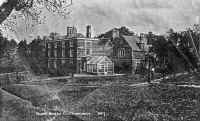
Bury House, from the rear
c1900
|
The oldest part of Bury
House (now named Cottingham Hall) was built in the 1690s, with new
sections added in the Georgian/Victorian era.
According to 'The Place-Names of Northamptonshire',
the name 'Bury House' literally means 'Manor House', with the word 'Bury' having
been derived from the Old English word for a fortified place 'burh' , which
later came to denote a fortified manor house.
The
owners of the house must have been away when the 1841 Census was taken, as there
are only servants listed - seven domestic servants living in Bury House itself,
with the gardener Eleanor Simpson and her family living in 'Bury Gardens',
which I believe were servants cottages in the grounds.
In 1881, the Simpson family are listed as living in 'Garden House' in the
grounds of Bury House. By 1901, Francis Simpson was
running a market gardening business from Mill Road.
At
the time of the 1901 Census, the house was unoccupied.
|
|
Owners
1870s
Kelly's Directory - The Honorable Mrs Pery
1890
Kelly's Directory - Rev Henry John Bigge
1903
Kelly's Directory
- Colonel C Grenville Mansel / Mrs Bigge
1906 and 1914
Kelly's Directory
- Colonel GE Ripley, JP
1929 - Captain George Lucas
|
|
Colonel
George Eustace Ripley
George Eustace Ripley was
born in 1864, the third son of Canon Ripley of Earlham Hall, Norfolk and
was educated at Rugby School. In 1896, he married Violet Sartoris of
Rushden Hall and the couple moved
to Bury House in 1902.
He was a professional soldier and, although he had
reluctantly retired just a few months previously, at the outbreak of the
First World War (aged 50), he applied to be reinstated and was given
command of the Northamptonshire
Regiment’s newly created 6th Battalion in October 1914.
The battalion embarked
for the Somme on 26 July 1915. Soldiers of the 6th included James
Simpson and William Claypole of Cottingham.
The battalion’s first tours of duty were relatively quiet, the main
threats being mines, though the Germans mounted a surprise trench raid on
29 December 1915. In March he was wounded by a stray shell and evacuated
to England to recover, but returned to the battalion in June 1916 to lead
his troops over the top.
While leading the battalion in the assault
on Thiepval on 26 September 1916, a German shell exploded next to him,
shattering his right arm which had to amputated at a base hospital. His
wife, Violet,
went out to France with
just two servants to bring her husband back to England but, tragically,
tetanus set in and he died of
heart failure in London just three weeks later on 16 October 1916.
He was buried in Cottingham churchyard and
there is also a window in his memory in St Sepulchre’s Church,
Northampton. Twice mentioned in despatches, the many testimonials made by
officers and men of the 6th Battalion showed that he was held in great
esteem and affection.
He was survived by his wife, their sons
Joseph and Roderick and a daughter. Mrs Ripley outlived her children,
dying in 1973 at the age of 96.
Lt Col Ripley’s grandson, George Burr, whose late mother
was born at Bury House on 29 September 1911, tells us “When my
grandmother died, I visited my grandfather’s grave as I had always been
charged by her to scatter her ashes on his grave. It took me ages to find
it on a desperately wet day blowing a gale. Being a trifle upset, and not
thinking too brightly, I tried scattering her ashes into the gale-a
considerable amount went onto and into me but she probably wouldn’t have
been unhappy at that!"
For more information, see
www.cottinghamsoldiers.org.uk/biogs/RipleyGeorgeE.html |
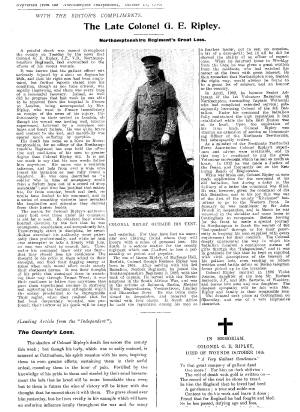
Obituary,
Northampton Independent, 21 Oct 1916
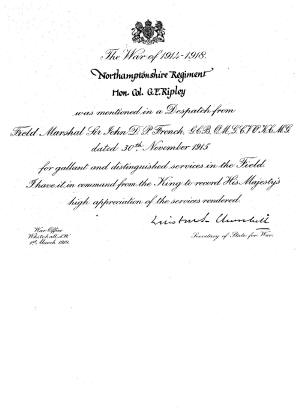

Mentioned in Despatches, 30
November 2015 and 13 November
1916 |
|
Captain George Lucas
Bury House was purchased by Captain George
Lucas in 1929, when he gave up the legal profession to become
Joint Master of the Woodland Pytchley Hunt, alongside Captain GE
Bellville. The following is an extract from Captain
Lucas’ book, ‘Memoirs of an Undistinguished Man’, published in 1955.
Recalling his first visit to Bury House, Captain Lucas says:
|
|
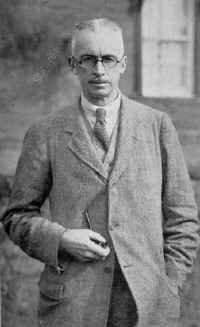
Captain George Lucas
|
"It was a beautiful little (!)
house, with about 20 acres of pasture and garden, and two of the most
attractive features were the paneled entrance hall with a stone floor
picked out in black squares, and the oak paneled dining room.
"It was
rumoured that a former owner of the property, wishing to improve the
seating in the church, had presented the Rector with rush seated chairs
and removed the old oak pews, which he subsequently used for paneling his
house.
"The inside was quite up to date, as the seller had done it up
thoroughly, and intended to live in with a relation who was a keen hunting
man. Soon after the agreement was arrived at the relation was
unfortunately killed in the hunting field and the other owner being unable
to carry on alone, decided to sell.
"The garden was almost derelict. There
would be no lack of employment if anyone wished to reclaim the garden from
the wilderness, and this was the deciding factor……
"We still live in it
and love it after 26 years, though the staff has gone down from nine to
three and one sometimes wonders whether it was worth the toil and expense
of keeping the place warm and habitable."
|

Josephine
Lucas |
Everyday life at Bury House
Local resident, Irene Beadsworth
(nee Ansell) also has memories of Bury House. She recalls how she
moved into the Bury House cottage in 1948 with her mother (Frances) and
father (Albert), when she was just six years old.
Says Irene: "My dad was
gardener at Bury House, and he also chauffered Captain Lucas, accompanied
him when he went out shooting and bred gun dogs. On one occasion, there
were three litters of puppies being looked after at the same time. For all of that, he
earned just £5 a week. My mum also used to spend a day cleaning and a day
cooking at Bury House - and she wasn't paid at all for that, but we did
get to live in the cottage rent free!"
Irene and her family lived at Bury House for
around four years, and later
moved to Barrack Yard off Corby
Road.
|
|
1960s
Bury House was purchased by John and Mary
Freestone around 1960, along with all the stables, outhouses and the
Spinney. John built Bury Close on the land where the Spinney stood, and
converted the stables and outbuildings into the Hunting
Lodge.
|
|
Legends
Bury
House is believed to be haunted by the ghost of a female servant who was pushed
from an upstairs window by the butler. Since then, her uniformed shadow has
haunted the area, looking for justice. She has also been sighted in Bury Close
and the Hunting Lodge.
Source
www.paranormaldatabase.com
|
|
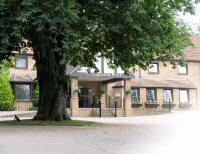
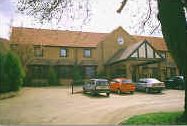
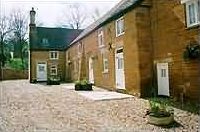
|
The
Hunting Lodge
The
Hunting Lodge was formerly the stables and outbuildings for Bury House. In
the 1960s/70s? the Hunting Lodge was a casino, and also at one time had a
grand ballroom.
The
stables and haylofts have been turned into self-contained cottages. The
groom used to live in the room above the saddle and tack room, which you
can see jutting out at the top end of the bottom photograph opposite. Otherwise,
these buildings were not lived in.
More
information available at www.huntinglodgehotel.com
|
|
back
to top of page
|
back to street index
|
|
|
|